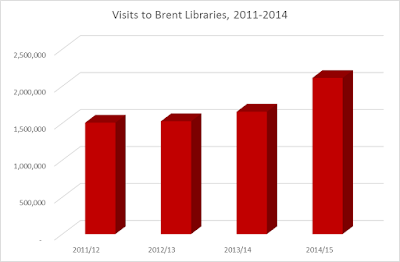The General Election has inspired gloom in many, not least in the library sector. I thought I would take another look at Brent's library numbers, which are actually rather cheering. I think people in some other parts of the country might take a look at Brent and see how public libraries have improved here despite massive cutbacks.
Firstly, lets look at the visit numbers since Brent passed its Libraries Transformation Project back in April 2011.
Annual visit numbers have gone up by 40% by the end of 31 March 2015, topping two million. The full table is here:
2011/12 1,506,852
2012/13 1,526,095 1.3%
2013/14 1,654,807 8.4%
2014/15 2,112,149 27.6%
Annual loan numbers for the same period are:
2011/12 985,590
2012/13 963,188 -2.3%
2013/14 996,930 3.5%
2014/15 1,021,180 2.4%
The third relevant test is the user satisfaction ratings, which are pretty good, although they have not been renewed for a while.
This performance is all the more remarkable given the general decline of library usage across the country. Brent libraries buck this trend.
Why are Brent Libraries Successful?
Many people find these numbers counter intuitive because in 2011 Brent decided to close half its libraries, and significantly reduce the overall budget. How therefore can the number of users and loans and satisfaction ratings all have increased?
My answer would be that, at least in a small urban area with good transport links, people can travel to a different library fairly easily. The second, often overlooked part of the answer, is that Brent deliberately improved the libraries that were kept open. Opening hours were extended to seven days a week. The book fund was protected (although it has now fallen back to a level just above Brent's CIFPA comparator Boroughs). Crucially, Brent also had major capital investment to improve its libraries in Kilburn, Wembley and Willesden as well as more minor changes in the other three.
This has also allowed the library service to engage more with changing social trends. Some have claimed that these trends make libraries obsolete. I think that changes in technology actually make libraries more relevant than ever, although with less of an emphasis on paper books.
Newer libraries are able to be able to be designed in a way that accommodates wireless technology more easily, as opposed to a model based on deskbound computers. Bigger libraries , such as Wembley, have more flexibility to deal with events, or with the different needs of users (such as small children who tend to be noisy as opposed to students who want quiet to study).
Why are Brent Libraries Important?
The importance of Brent libraries for other areas is that they show a model that can be made to work despite continuing cuts in funding. Granted it is a model for urban areas, and rural areas face very different problems. However, the present government has been re-elected, and looks set to continue to continue its library policy. An example like Brent, which shows that public library services do not just have to be about nothing but ongoing cuts, should be welcomed.
UPDATE
I have answered the comment below querying the role of fire drills in a separate post.

1 comment:
Library user numbers?
At Wembley 'user' numbers include Brent Council staff and the public who use the same entrance to the library and also include as users numbers in fire drills who evacuate and also re-enter the building - using the same entrance as the library.
How do you disaggregate the figures to show an honest picture?
Post a Comment